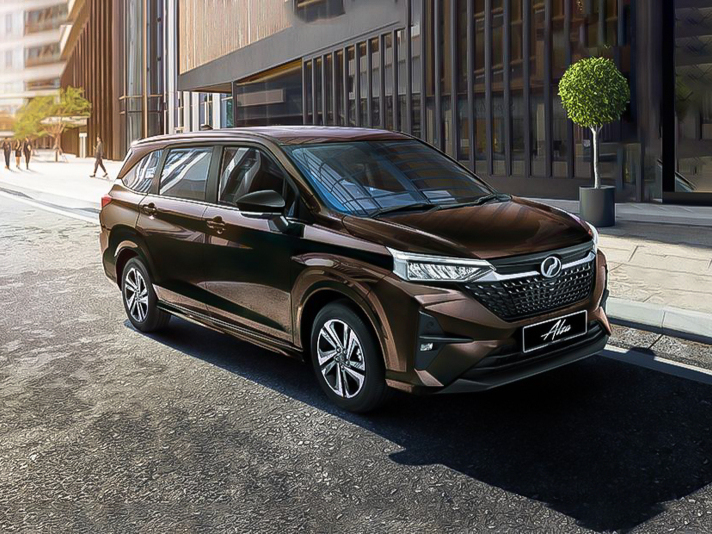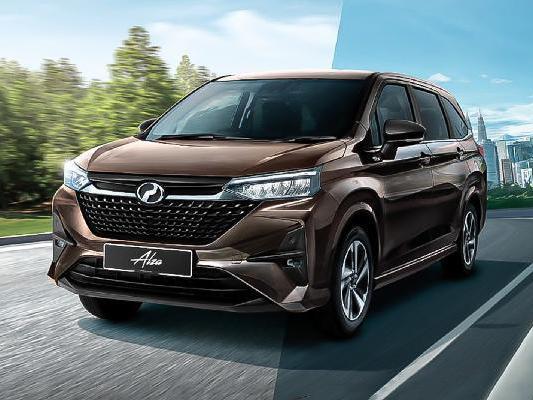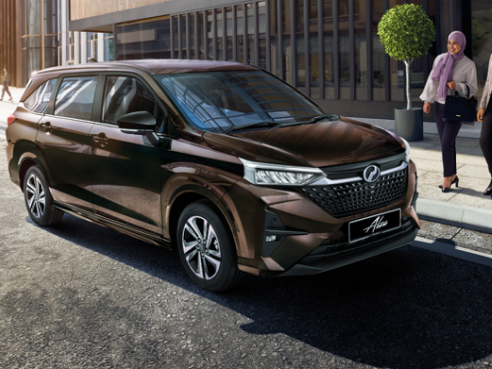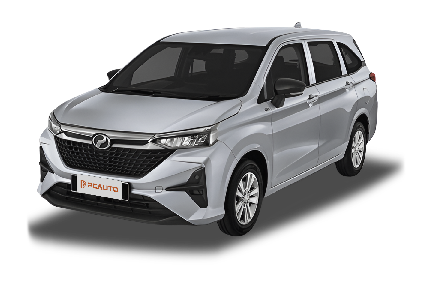Q
What are the Perodua Alza Problems? Learn Before You Buy
As a popular seven-seater MPV in the Malaysian market, the Perodua Alza has some common issues. Some owners have reported that its sound insulation is just at average level, with wind and road noise being quite noticeable when driving at high speeds. Also, the 1.5L naturally aspirated engine may lack a bit of power when the vehicle is fully loaded. When climbing hills, it's necessary to raise the engine speed. The interior is mainly made of hard plastics, which might produce slight rattling noises after long-term use. The third row is more suitable for children or short trips.
In addition, the early models of the CVT transmission used to have occasional jerks during cold starts, but this problem has been significantly improved after the manufacturer's software upgrade. It's worth noting that the Alza's fuel consumption (about 15 km/L) and low maintenance cost are still its advantages. After the 2022 model change, the chassis tuning is more focused on comfort, solving the problem of the hard suspension of the previous model.
It is recommended that potential buyers take a test drive first and check the condition of used cars (such as electronic devices and air - conditioning systems). They should also compare with models in the same class, like the Proton Ertiga or the Toyota Avanza, and weigh the space and configuration according to their family's needs. Generally speaking, the Alza is suitable for families with a limited budget who value practicality. However, if you're looking for stronger power or a more luxurious feel, you may need to consider higher - priced models.
Special Disclaimer: This content is published by users and does not represent the views or position of PCauto.
Related Q&A
Q
Is 2022 Perodua Alza FWD or RWD?
The 2022 Perodua Alza is a front-wheel drive (FWD) vehicle. This is also a common drive layout design for Perodua's MPV models. The advantage of front-wheel drive lies in its relatively simple structure, lower manufacturing cost, and better fuel economy. It's highly suitable for Malaysia's urban roads and daily family use. As a seven-seater MPV that focuses on practicality and cost-effectiveness, the front-wheel drive design of the Alza also helps optimize the interior space, especially the practicality of the rear seating and the trunk. For Malaysian consumers, front-wheel drive performs relatively stably on slippery roads, and the maintenance cost is also low. These are features that family users value highly. It's worth mentioning that although there are also rear-wheel drive (RWD) or all-wheel drive (AWD) MPV models on the market, these designs are usually used for vehicles with higher performance or off-road requirements. The Alza is more positioned towards being economical and practical, so front-wheel drive is a choice that better suits its market positioning. If consumers have further questions about the drive system, they can consult Perodua's official dealers for more detailed technical explanations.
Q
What is the ground clearance of 2022 Perodua Alza?
In 2022, the ground clearance of the Perodua Alza is 150 millimeters. This design allows it to offer good passability on both common urban roads and suburban road conditions in Malaysia, while also taking into account ride comfort. Ground clearance is an important indicator for measuring a vehicle's passability. For the variable road conditions in Malaysia, a ground clearance of 150 millimeters can handle most speed bumps, uneven roads, and mildly rough terrains. However, if you often drive on extremely rough or muddy sections, it is still recommended to drive with caution. As an MPV that focuses on practicality and family needs, the design of the Perodua Alza's ground clearance also takes into account the convenience of getting in and out of the vehicle, which is especially suitable for family users with the elderly or children. In addition, the ground clearance also affects the vehicle's center of gravity and handling stability. The setting of the Alza optimizes the stability during high-speed driving while ensuring passability, making it suitable for long-distance driving. If you need to further improve the passability, you can choose to install the original or certified chassis guards, but note that this may slightly affect fuel economy.
Q
Does Perodua Alza 2022 have turbo?
None of the models in the 2022 Perodua Alza lineup are equipped with a turbo engine. Its powertrain features a 1.5-liter four-cylinder naturally aspirated gasoline engine (coded 2NR-VE), with a maximum output of 106 horsepower and a peak torque of 138 Nm. It is mated to a D-CVT transmission, focusing on fuel economy and family practicality needs. Although this car doesn't have turbocharging technology, its power performance is sufficient for daily urban commuting and family trips. Moreover, the naturally aspirated engine has a relatively simple structure and lower maintenance costs, making it suitable for Malaysian consumers who value practicality. If you're interested in turbocharged models, you can keep an eye on Perodua or other competing models in the same class from other brands, such as the Proton X50. However, it should be noted that while turbo engines can enhance power performance, they may bring higher maintenance costs and fuel requirements. Overall, the 2022 Alza is designed to focus more on space utilization and cost-effectiveness, which is in line with Perodua's consistent market positioning.
Q
How many people can fit in Alza 2022?
The 2022 Perodua Alza is a popular 7-seater MPV in the Malaysian market. Its standard configuration can comfortably accommodate 7 adults, featuring a 2+2+3 seating layout. The second-row independent seats offer flexible adjustment space, and the third row is suitable for medium-built passengers on short trips. With a wheelbase of 2,750mm, this model optimizes legroom. The trunk can still hold small luggage when the car is fully occupied, and folding the third row can significantly increase the cargo capacity.
Notably, all versions of the 2022 Alza come standard with ISOFIX child safety seat anchors, making it a great choice for family users. The combination of its 1.5L Dual VVT-i engine and D-CVT transmission balances fuel economy (official data shows 5.8L/100km), which is especially suitable for the diverse road conditions in Malaysia. This car has also received a 5-star safety rating from ASEAN NCAP and is equipped with the ASA 3.0 active safety system, demonstrating strong competitiveness among its peers.
For consumers considering a 7-seater vehicle, it is recommended to take an actual test drive to experience the third-row space. At the same time, compare the space layout and configuration differences with similar models such as the Toyota Veloz, and choose the most suitable MPV according to your family's needs.
Q
How big is the boot on Perodua Alza 2022?
The 2022 Perodua Alza has a luggage compartment with a volume of 137 liters. This space is sufficient for daily family use, such as placing several small and medium-sized suitcases or shopping bags. For Malaysian families, this capacity is very practical for urban commuting or short trips. If more space is needed, the storage area can be expanded by folding down the rear seats, offering high flexibility. In the Malaysian market, as an economical and practical MPV, the luggage compartment design of the Alza combines daily convenience and space utilization, making it suitable for consumers who value practicality.
In addition, when considering the luggage compartment volume, it's also necessary to pay attention to the actual loading method. For example, arranging items reasonably can maximize the use of space. It is also recommended to personally experience the actual vehicle space before purchasing a car to ensure it meets your personal needs, as the actual usage experience may vary depending on the shape and quantity of luggage.
Q
What is the fuel consumption of Alza 2022?
The fuel consumption of the 2022 Perodua Alza varies depending on driving conditions and configuration. Official data indicates that equipped with a 1.5L 2NR-VE Dual VVT-i engine and CVT transmission, its combined fuel consumption is approximately 5.5 to 5.8 liters per 100 kilometers. Specific figures may fluctuate based on urban or highway driving conditions. Actual fuel economy is also influenced by factors such as driving habits, load, and air conditioning usage .
For Malaysian consumers, the Alza, as an economical MPV, offers commendable fuel efficiency within its class, making it suitable for family daily use . To further reduce fuel consumption, it is recommended to maintain regular vehicle maintenance, avoid rapid acceleration and hard braking, and ensure tire pressure is at the normal level .Additionally, frequent use of air conditioning in Malaysia's hot climate can impact fuel economy. Therefore, selecting an eco-driving mode or planning routes reasonably can also help save on fuel costs .
Q
What is the top speed of Alza 2022?
The 2022 Perodua Alza has a top speed of 170 km/h. This data is based on the performance of its 1.5-liter 2NR-VE naturally aspirated engine with Dual VVT-i (106 horsepower/138 Nm) and the D-CVT gearbox, which suits its positioning as a family MPV. This model stands out in fuel economy and practicality, with an official fuel consumption of 5.8 liters per 100 km (combined conditions), making it suitable for daily commuting and long-distance travel of Malaysian families. It should be noted that the actual top speed may be affected by factors such as load, road conditions, or driving habits, and the electronic speed limit system will also intervene to ensure safety. As a popular local model, the 2022 Alza also comes standard with the ASA 3.0 active safety system (including pre-collision warning and lane departure assistance). Such configurations are quite competitive among models in the same class. It is recommended that car owners conduct regular maintenance to maintain optimal performance and comply with the legal speed limit of 110 km/h on Malaysian highways.
Q
What engine is in the Alza 2022?
The 2022 Perodua Alza is powered by a 1.5-liter 2NR-VE four-cylinder naturally aspirated engine. This engine adopts the Dual VVT-i dual variable valve timing technology, with a maximum output power of 106 horsepower and a peak torque of 138 Nm. It is paired with a D-CVT continuously variable transmission. The overall power performance is smooth, and it has excellent fuel economy, which is very suitable for daily family use. This engine has been verified in the Malaysian market for many years. It has mature and reliable technology, and the maintenance cost is relatively low, which is one of the important reasons why many consumers choose the Alza. It's worth mentioning that the addition of the D-CVT transmission further enhances the driving comfort and fuel efficiency, enabling the Alza to perform excellently on both urban roads and highways. For Malaysian consumers, the engine configuration of the Alza balances power and fuel economy while meeting the needs of the local driving environment. It is a cost-effective choice for a family MPV.
Q
What is the price of Alza 2022?
The 2022 Perodua Alza is priced between RM62,500 and RM75,500 in Malaysia. The specific price depends on different model versions, including configurations such as 1.5L AV, 1.5L H, and 1.5L X. This MPV is popular among local family users for its affordable price and practicality.
The 2022 Alza is equipped with a 1.5 - liter Dual VVT - i engine, which delivers 107 horsepower and 136 Nm of torque, and is paired with a Dual-mode CVT transmission. It has excellent fuel economy, making it suitable for city driving.
The interior is equipped with a 7 - inch touchscreen, a multi - function steering wheel, and 6 airbags (in the high - end version). It has strong space flexibility and can accommodate 7 passengers. The second - row seats can be slid and adjusted to enhance comfort or increase cargo space.
As a classic model of Perodua, the Alza has a high market retention rate in Malaysia, relatively low maintenance costs, and a relatively stable second - hand resale value. It is one of the popular choices for budget - conscious families when considering an MPV. It is recommended to take a test drive at an authorized dealer and learn about the latest promotion plans before purchasing a car.
Q
What Segment is Perodua Alza?
The Perodua Alza falls into the B-Segment. It's a 7-seater compact MPV with a stylish design and a spacious cabin. The body is relatively compact, and the three rows of seats offer various arrangements. In the full model change, it adopts the DNGA B-segment platform, which further optimizes the interior space, making it more spacious and user - friendly. Among models in the same class, it has certain advantages and can meet various needs such as family outings. Its space layout is reasonable, ensuring both the passengers' riding comfort and a certain amount of storage space. Meanwhile, it also has corresponding features in terms of fuel economy and safety configuration, providing consumers with a good choice.
Latest Q&A
Q
how much does a bmw ix cost
Right now, the Mazda 3 Hatchback is available with a hybrid (M Hybrid) option in global markets, but there's still no fully electric version. Here in Malaysia, the Mazda 3 Hatchback lineup is pretty much all about the Skyactiv-G petrol engines – hybrids and EVs haven't made their way here yet.
Mazda's hybrid setup pairs an efficient internal combustion engine with mild hybrid tech. It's all about recovering energy and using the electric motor to give the engine a little help, which translates to better fuel economy. Definitely a solid pick if you're someone who prioritizes saving at the pump.
If you've got your heart set on a greener ride, though, there are other hybrid options in Malaysia. Think models like the Toyota Corolla Cross Hybrid or the Honda City e:HEV – those are worth checking out.
Mazda's probably going to expand its electrified lineup down the line, but for now, your best bet is to hit up your local dealer to see what's new. Oh, and don't forget – the Malaysian government offers tax incentives for new energy vehicles. It's a good idea to look into the latest policies before you buy, so you can find the perfect car that fits both your needs and the current offers.
Q
bmw ix how to open charging port
In the current Malaysian market, the Mazda 3 Hatchback is offered in three main trim levels for consumers to choose from: the entry-level Mazda 3 Hatchback 1.5L Mid, the mid-range Mazda 3 Hatchback 2.0L High, and the top-spec Mazda 3 Hatchback 2.0L High Plus.
The 1.5L Mid is powered by a 1.5-liter Skyactiv-G engine, making it a solid pick for those who prioritize fuel efficiency. It comes equipped with LED headlights, an 8.8-inch infotainment screen, and essential safety features like blind-spot monitoring.
Stepping up to the 2.0L High gets you a more potent 2.0-liter engine, along with upgrades such as leather seats, power-adjustable driver's seat, and a more comprehensive i-Activsense safety suite.
At the top of the range, the 2.0L High Plus adds even more premium touches, including a Bose sound system, a panoramic sunroof, and a 360-degree surround-view camera.
Across all trims, the Mazda 3 Hatchback boasts the brand's distinctive Kodo design language, with an interior crafted from high-quality materials that really showcase that Japanese attention to detail and fine craftsmanship.
Malaysian buyers can pick the trim that best fits their budget and needs, and it's worth noting that Mazda models come with a 5-year free maintenance package locally – a nice bonus that adds to their long-term ownership value.
Q
bmw ix how much
In Malaysia's hot hatch segment, the Mazda3 Hatchback goes head-to-head with heavyweights like the Honda Civic Hatchback, Toyota Corolla Hatchback, and Volkswagen Golf. What really makes the Mazda stand out though? That signature Kodo design language and a cabin that feels way more premium than its price tag suggests. Those sleek lines and high-quality materials inside? Total eye-catchers in this class.
Under the hood, Mazda's Skyactiv-G engine strikes a solid balance between fuel efficiency and pep. Sure, it might not match the Civic Hatchback's 1.5T in raw horsepower numbers, but the linear acceleration and sharp handling tuning here are pure joy for drivers who actually love being behind the wheel.
Space-wise, the Mazda3 Hatchback's rear legroom is a bit tighter than the Corolla Hatchback's, but trade that for seats that feel more supportive on long drives and cabin quietness that drowns out road noise better than most rivals. And let's not sleep on the standard i-Activsense safety suite – it's packing class-leading active and passive tech that should definitely appeal to safety-conscious Malaysian buyers.
Pricing lands it slightly above its Japanese competitors but undercuts the European players, carving out a nice sweet spot in the market. So, for Malaysian shoppers prioritizing head-turning design, engaging driving dynamics, and a cabin that feels genuinely upscale, the Mazda3 Hatchback is a strong contender. But if outright space or blistering turbo power is your top priority? You might want to cross-shop those other options.
Q
how much is ix bmw
The current Mazda3 Hatchback in Malaysia offers a palette of exterior colors including the signature Soul Red Crystal, Machine Gray, Snowflake White Pearl, Deep Crystal Black, and Polymetal Gray. These hues aren't just about showcasing Mazda's iconic Kodo: "Soul of Motion" design philosophy—they're brought to life using the brand's proprietary high-gloss painting technology, which gives the bodywork incredible depth and dimension that shifts beautifully under different lighting conditions.
Standouts in this lineup are undoubtedly Soul Red Crystal and Polymetal Gray. Soul Red Crystal achieves its head-turning depth through a unique layering process of aluminum flakes and reflective coats, while Polymetal Gray uses a multi-layer application to create a sophisticated metallic finish with a modern edge.
For Malaysian buyers, choosing a color isn't just about personal taste—practicality plays a role too. Darker shades like Machine Gray or Deep Crystal Blue really accentuate the 3's sculpted lines but can show fine scratches more easily, whereas lighter options like Snowflake White Pearl tend to hide dirt better and stay cooler under our intense tropical sun.
Mazda's paint technology is built tough, with excellent rust resistance and durability to handle Malaysia's rainy, humid climate. A regular wax every few months will help keep that factory-fresh shine locked in for years to come, though—definitely worth the little extra effort.
Q
berapa harga bmw ix
To experience the Mazda 3 Hatchback, you can schedule a test drive at authorized Mazda dealerships throughout Malaysia, such as Bermaz Motor in Kuala Lumpur, Mazda Auto Fabulous in Penang, or Mazda Southern in Johor. It is advisable to first visit the official Mazda Malaysia website to locate your nearest dealership and make an advance appointment to ensure the availability of the test drive vehicle.
The Mazda 3 Hatchback has gained popularity for its excellent handling and the striking Kodo-Soul of Motion design language. It is equipped with the efficient Skyactiv-G engine and i-Activsense safety technology. During the test drive, we recommend paying particular attention to the precision of the steering response and the quality of the interior materials. It is also beneficial to compare the differences between various trim levels, such as the High Plus and High Spec versions.
If you are considering a purchase, be sure to inquire with the dealership about current promotional offers and the comprehensive 5-year manufacturer warranty. This model is well-suited for young families seeking an engaging driving experience without compromising on everyday practicality.
View MoreRelated News

Perodua Alza Interior Design Revealed: Malaysia's Top Choice for Family MPV
AshleyJul 23, 2025

A Complete Guide to Perodua Alza: Must-Read Money-Saving Tips for Car Buyers
RobertMar 25, 2025

What will the new Perodua Car look like in 2025? What kind of changes will they undergo?
LienMar 3, 2025

Produced by the same factory, why is there nearly a RM20k price difference? How to choose between Perodua Alza and Toyota Veloz?
JamesOct 21, 2024

Perodua Alza: Priced from RM 62,500, the most cost-effective all-round MPV?
LienMay 31, 2024
View More

















Pros
Cons